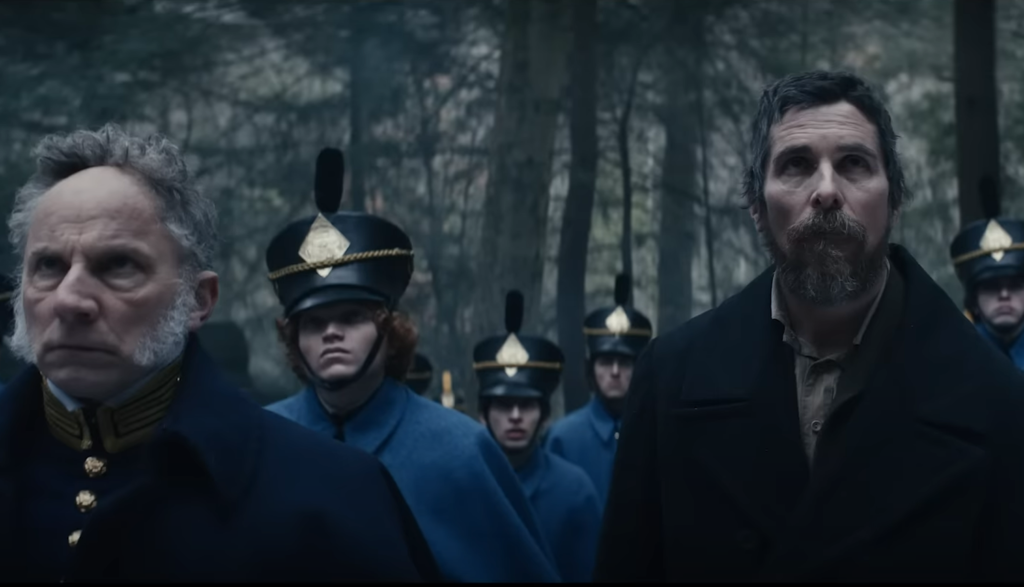
The boundaries which divide Life from Death are at best shadowy and vague. Who shall say where the one ends, and where the other begins?
This question, posed by author Edgar Allan Poe, is examined when the dead body of a cadet attending the United States Military Academy at West Point in 1830 is discovered.
The circumstances of his death aren’t suspicious to the school’s officers. He died by hanging, seemingly self-induced—which was not uncommon due to the harsh regulations imposed upon the cadets.
However, when the cadet’s corpse is found sans heart the following day, the instructors are shocked.
Who could commit such an evil and, ahem, heartless act?
They call upon Augustus Landor to solve the mystery. A retired New York City constable, Landor made a name for himself breaking up gangs, apprehending their leaders and solving grisly murders. His use of modern forensics, codebreaking and “gloveless interrogation” make him well-suited to ferret out the guilty party.
Landor secretly employs a young cadet and poet—none other than Edgar A. Poe himself—to help him in his investigation. But as Landor and Poe begin to piece the clues together, more deaths occur. And they learn there’s much more than murder afoot at West Point.
None.
Poe says early on that his mother (who has been dead for 20 years) speaks to him frequently. We later hear that a young woman reports communing with her dead relatives, too. Landor also seems to see someone who isn’t there, but it turns out to just be a delusion.
Though Poe quotes Psalm 51:10 and says he enjoys talking about God and death, it’s evident that faith is not important to him. Rather, he just finds the topic fascinating.
Church and prayer service attendance is mandatory for cadets. We see a woman praying before a portrait of Christ. The Bible is read by a priest at a funeral service.
Landor and Poe quickly deduce that the killer might be involved in the occult, since the heart is used in those practices. Landor confirms this theory when he discovers a ritual site. A passage mentioning “evil angels” and witches’ “Sabbath feast” is read from a book written by a “witch-hunter.” And it’s rumored that another occult book contains instructions for attaining immortality.
[Spoiler Warning] That book is later discovered in the hands of the witch-hunter’s descendants. The family attempts to perform the immortality ceremony (which requires lots of blood, chanting in Latin and a human heart) to heal his great-great-granddaughter of her seizures.
We hear that Landor was a minister’s son, but he admits he hasn’t “darkened the door” of a church in a long time.
Landor frequents the bed of Patsy, a local barmaid. We see them lying in bed together (Landor shirtless in one scene). A prostitute us referenced. Poe recites a poem that mentions nudity and sex.
We see the mangled corpses of two cadets, both hanging from nooses. The first man, Fry, is assumed to have died by suicide. However, his body is later found cut open with his heart missing. Upon further examination (which we witness), it’s discovered he suffered blunt force trauma to the back of his head prior to the hanging, evidence that reveals he was murdered. The second man is found with his heart already removed, leaving no question that his death was a homicide. (It’s also revealed he was castrated.) Later scenes show these two crimes being committed by the perpetrator, and both men are beaten badly before they are killed.
A young man and woman are crushed to death by falling ceiling beams during a fire. A man is partially drained of his blood and nearly has his heart surgically removed for an occult ceremony. We see the bodies of a cow and sheep (both missing their hearts) pinned to a tree.
We hear that a woman’s illness killed her slowly and painfully. Another woman experiences a seizure; she falls to the ground, unable to breathe during the episode (which we learn that she has frequently).
During an autopsy, Landor snaps open stiff fingers that have undergone rigor mortis in order to retrieve a note stuck in the dead man’s hand. (The chest cavity is also pulled open during the examination of the body, and we see bruises on the neck from hanging.)
Poe get tackled, beaten and nearly killed by a fellow cadet before Landor stops the attack. Later, Poe threatens to kill the young man if they ever “cross swords” again. We hear this isn’t the first scuffle Poe has been in with another cadet. And Poe admits that if he were to actually kill every person who had abused him at the Academy, the Corps of Cadets would number fewer than a dozen.
Two men fight, one of whom has a knife. They are stopped when falling ceiling beams, caused by a fire, distract them. The unarmed man saves two people from the flames while the armed man is killed.
Poe reads a book that says witches eat “hearts of unbaptized children” and “hearts of hanged men.” We hear a man was burned at the stake.
A woman slams a plate down, breaking it.
[Spoiler Warning] A young woman is raped by three men (we see the beginning of the attack but not the actual act). She returns home bleeding with a torn dress. Later, she ends her life by jumping off a cliff.
We hear three uses of the f-word and one of “b–tard.” Christ’s name is abused once, and God’s name is abused six times.
Landor is instructed not to drink during his investigation (because he has the reputation of being a drunkard), but he imbibes anyways. We see people drinking at a bar. Many casually sip wine and liquor with meals.
A man is unknowingly drugged.
We learn that Poe has been bullied by other cadets since his arrival because of his physical appearance and odd mannerisms. Others believe the Academy goes too far in its regulations, making the men who attend less human and less reasonable. And some of those affiliated with the Academy question its practices, since those regulations have produced suicides and ritual murders.
When a man justifies the people he’s killed, his friend states that it wasn’t the right thing to do. But instead of turning him in, the friend burns the evidence of his wrongdoing.
We hear that Landor lost his wife to illness and that his daughter recently ran off.
Characters lie. Landor snoops through people’s personal belongings and homes without permission. Cadets gamble and break curfew. Despite serving in the military, Poe demonstrates an unpatriotic attitude. A woman tries to manipulate her paramour using love as an excuse.
Death is a natural part of life. We all face it eventually. Some, perhaps, more spectacularly than others—especially if you happen to be a character in one of Edgar Allan Poe’s works.
The Pale Blue Eye isn’t based on any of Poe’s poems or short stories, though some of the characters here got their names from his tales, and the film’s title and theme borrow from “The Tell-Tale Heart.” But it still seems to follow that pattern.
Based on the book of the same name by Louis Bayard, the story is fictional. And it explores a theme repeatedly brought up in Poe’s works: death and the ability of man to bring it about.
As such, it’s a brutal film to watch. Men are savagely murdered. A young woman is raped. We witness a suicide. Occultists seek immortality through ceremonial mutilation of the dead.
And there’s no absolution found. Justice is served unjustly. Guilty parties walk free. And characters remain tortured by their own inner demons.
If you’ve read any of Edgar Allan Poe, this won’t surprise you. But The Pale Blue Eye might still prove too macabre even for the most seasoned student of Poe’s works.


Emily studied film and writing when she was in college. And when she isn’t being way too competitive while playing board games, she enjoys food, sleep, and geeking out with her husband indulging in their “nerdoms,” which is the collective fan cultures of everything they love, such as Star Wars, Star Trek, Stargate and Lord of the Rings.